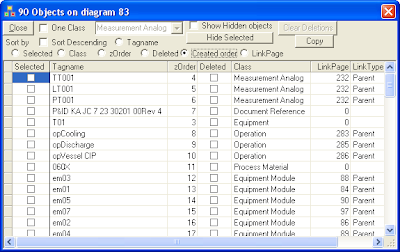The latest version, 1218 of ControlDraw provides new ways to look at the structure of a model.
The Field Inherits Map
This shows each field name where it's Special Default is !Inherit and the classes that the field value will pass through.
A drop down box lists all the inherited fields so you can pick one.
The Model Class Hierarchy
Note that these are automatically available - you do not have to draw them, they are built from the data in the model
Wednesday, 16 November 2011
Thursday, 23 June 2011
How Process Engineers could use ControlDraw in early project stages
ControlDraw may never be suitable for large P&ID's, but I think it is already more than capable of producing PFD's and much more, including simple P&ID’s that could be used as a starting point for the CAD versions.
The diagram below is intended to show how Process Engineers could use ControlDraw in early project stages.
Labels:
PandID,
PFD,
Piping and Instrument Diagrams
Monday, 23 May 2011
ControlDraw version 3.6.1210 - Faster and Smarter
This new release provides some great improvements, especially for those of you who have large models and who want to use the Recipe Modelling capabilities to define master recipes.
The improved Diagram List view - this now shows the link page and link type and allows you to change them and to change object classes.
In addition it is now possible to view and hide/unhide diagram objects from the List View.
Hidden objects do not appear on diagrams but still generate data.
If a diagram has hidden objects a count of them automatically appears on the diagram. There is also a new special symbol, 'Hidden Symbols' that you can put on a diagram to show a list of them
The improvements with handling large models are mostly speed, large diagrams load much faster and the data build process has been accelerated. Where ControlDraw used to read the records and rebuild all objects when a diagram was opened and then save all the records when the diagram was closed, it now (optionally) only reads and updates on a symbol basis. For large diagrams the improvement is large, a complex diagram with about 200 objects including a large state matrix now loads in under 2 seconds compared with 8 seconds on a 3 yr old PC that is not state of the art.
The Recipe Modelling developments are mainly intended to support recipes that can have a large number of parameters. For example the Descended Objects view can be used to create parameters in a Recipe Procedure by scanning all the child hierarchy of a recipe type diagram and finding all the lower level parameters (typically in Phases or Operation) and making copies of them.
In addition it is now possible to view and hide/unhide diagram objects from the List View.
Hidden objects do not appear on diagrams but still generate data.
If a diagram has hidden objects a count of them automatically appears on the diagram. There is also a new special symbol, 'Hidden Symbols' that you can put on a diagram to show a list of them
When using the Descended Objects to create recipe parameters you are now asked whether to make them hidden. This is mainly intended to support things like recipes that can have a large number of parameters that you still want in the data tables.
The improvements with handling large models are mostly speed, large diagrams load much faster and the data build process has been accelerated. Where ControlDraw used to read the records and rebuild all objects when a diagram was opened and then save all the records when the diagram was closed, it now (optionally) only reads and updates on a symbol basis. For large diagrams the improvement is large, a complex diagram with about 200 objects including a large state matrix now loads in under 2 seconds compared with 8 seconds on a 3 yr old PC that is not state of the art.
Labels:
ControlDraw Release
Sunday, 22 May 2011
Pharmaceutical Fermenters
I have recently been looking at ControlDraw models for large scale Pharmaceutical Fermenter Units from 4 different companies. All are broadly similar
I cannot publish them because because they are confidential, agreements signed!
I cannot publish them because because they are confidential, agreements signed!
However I have summarised them using some statistics from the models. (Click to enlarge)
Some differences are immediately apparent.
Why is the IO Count for Client 3 so low? This is because they do not use limit switches on their valves. This is something I have never understood as it seems to me that any cost savings would be obliterated by the downtime cause by the inablity to quickly diagnose valve failures.
Why do Clients 1 and 3 have so many parameters? I think that this is in part because they do not distinguish between critical parameters (that can be changed to define the product or CIP ) and other parameters
Monday, 16 May 2011
ControlDraw verison 3.6.1208 improves Recipe Parameter Handling
This version has greatly improved the Descended Object Linking.
You can use this to establish links between objects, typically Recipe parameters.
For example you can create a link between a Master Recipe parameter on a Cell Level Recipe procedure and the corresponding parameter on the phase that actually deploys the parameter. Then you can using the new Parameter Map show the link and the Unit Procedures and Operations that the parameter has to pass through to get to the phase.
The Parameter Map below show 4 Master Recipe Parameters that are linked via Recipe Procedures and Operations down to phases. (In this example the Uit Procedure level is not used)

You can also use this to create Master Recipe Parameters by looking down the hierarchy and to find all the parameters that the Entire Recipe Procedure uses and then selecting some of them to be Masters.
Subscribe to:
Comments (Atom)





